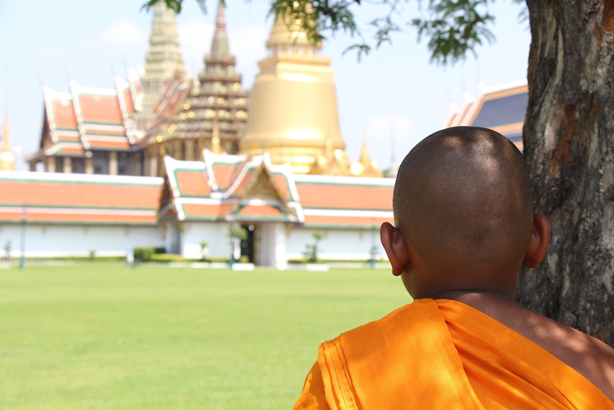Buddhist Monuments Destroyed By Natural and Man-Made Calamities
Buddhism is an ancient culture, which spread across all the seven continents in the space of time. Along with the philosophy, Buddhist temples and monasteries were built, and some of them continue to remain even today. However, mother nature hasn’t been generous with everything, and certainly not with all ancient monuments.
Similar is the case with Buddhist architecture. While some have managed to survive the wrath of changing environment over time, many have been destroyed, some through natural wear and tear, and others through natural calamities. Most of Buddhist monuments were built in nature intensive regions, like mountains, forests, secluded islands, etc. All these, unfortunately, are prone to calamities like floods, cyclones, earthquakes, and landslides.
Here are a few examples where many exquisite Buddhist monuments were destroyed due to calamities caused nature’s intervention and man's evil intention.
- Myanmar Temples Destroyed In Cyclone (2008)
Myanmar, also known as Burma, us one of the few countries in the world with a Buddhist majority population. The country has a rich cultural history, and has played an important part in spread the message of Gautama Buddha in Southeast Asia.
Buddhism reached the Burmese shores over 2,000 years ago, and therefore, the land is a home to some of most ancient Buddhist architecture. However, most of them were either complete destroyed or bad damaged during the horrific cyclone of the summer of 2008. The cyclone was named as Cyclone Nargis, and scientists consider it to be the worst recorded natural disaster in the history of Myanmar. Nargis left over 1,40,000 people dead, out of the 1.5 million severely affected people.
As per an estimate by the country’s Ministry of Religious Affairs, over 1,400 ancient and medieval monuments, including monasteries and temples, where severely hit. Most of these structures were completely destroyed, while some sustained major blows. 95% of total standing buildings in Burma lost ground and were demolished completely.
- Buddhist Temples In Nepal Destroyed By Earthquakes (2015)
The 2015 earthquakes of Nepal were some of the worst recorded in modern history. Thousands of people lost their lives, tens of thousands were severely injured. Apart from this, the calamity caused a humongous loss of property, including several UNESCO World Heritage Sites.
Nepal is homeland for the great Himalayan Mountains, a region popularly linked Buddhist monks and monasteries. The country houses some of the oldest Buddhist monuments in the world, some even as old as 1,200 years old. Nepal, along with Tibet, is one of the few places in the world which still holds Buddhist traditions, with monks occupying monasteries even today, which was the reason for the ancient monasteries being preserved with all their glory.
However, the horrific earthquakes of 2015 destroyed almost every major Buddhist structure, among over 1,000 others. The famous structures which crumbled down include Kathmandu Durbar Square, Bhaktapur Durbar Square, Boudhanath Temple, Changu Narayan, Lumbini, Patan Durbar etc. Even after four years of the calamity, these magnificent haven’t been restored completely, which shows that replicating ancient Buddhist architecture is easier said than done.
- Nalanda Monastery Destroyed Due To Natural Wear And Tear (700s-2019)
India houses several great Buddhist monuments, most of which are situated it the mighty Himalayas and the north-eastern hilly regions. However, two of the most iconic structure of Buddhist tradition, Bodh Gaya and Nalanda, are located in Bihar. Gaya is the place where Gautama Buddha attained enlightenment, while Nalanda was built to educate the world about spiritual and worldly sciences in the Buddhist curriculum.
Nalanda, is considered to be the oldest university in India, and according to some historians, it is oldest in known to mankind. The structure dates back to over 1,600 years during the reign of Ashoka The Great, the stalwart Mauryan emperor, who embraced Buddhism after the great bloodshed of Kalinga war. Initially, large monasteries with all basic facilities required to preach students from far and wide.
However, with the decline of the Maurya Empire, the importance and popularity of Nalanda began to fall, which resulted in abandoning of the great university. It was once considered as the center of knowledge and spiritual excellence, and some of the eastern world's biggest philosophers, and scholars like Xuanzang and Yijing, are alumni of Nalanda.
Unfortunately, this glorious structure is know in complete ruins to due to natural wear and tear, especially since its decline in 1200 CE, when the Mamluk Dynasty invaded the region. As people abandoned the place, it couldn’t be maintained, and the current fallen structures present at the site give a glimpse of the glorious past, invoking immense nostalgia.
- Jokhang Monastery Fire (2018)
When you talk anything related to Buddhism, you simply cannot end the discussion without mentioning Tibet. The mountain region is world famous for its Buddhist heritage sites, surrounded by snow-capped mountains and saintly yaks, and inhabited by monks deeply engrossed in meditation.
None of the exquisite architectural marvels in Tibet are as precious as the Jokhang Monastery, situated in Lhasa. It is considered to be the holiest place by Buddhists in Tibet, and it epitomizes Buddhist culture. The Jokhang Monastery was built in the 7th Century, and was as magnificent as day one until recently.
Unfortunately, the highly popular monastery saw its day in 2018, when Jokhang Monastery was seen burning from a distance on the eve of 17th February. The reason of fire hasn’t been ascertained yet, but fact is that the biggest and the most loved monastery in the country was burned down, and not many know how bad the damage has been done. Nonetheless, the fire seems to be a consequence of human intervention, and damages could be enormous.
- Namdaemun Gate Fire In South Korea (2008)
Namdaemun Gate was one of the eight historic gates of the Fortress Wall of Seoul. It is one of the oldest structures in the country, and is regarded as the first National Treasure of South Korea. Namdaemun was first built 1398 by Taejo of Joseon, making it the oldest wooden structure in South Korea.
The Namdaemun is a perfect example of medieval Buddhist architecture. It was made by wood and stone, with pagoda style roof top. It had two main purposes, welcoming foreign emissaries to the city, and protecting the city from the then most feared predator, the Siberian Tiger. Namdaemun personified the influence of Buddhist culture in kingdoms of East Asia, which is reflected even today.
In the winter of 2008 during the month of February, the historic Namdaemun Gate caught fire, which resulted in a total destruction of the structure. About 360 firefighters worked tirelessly to extinguish the fire, but the wooden structure couldn’t be saved. Initially it was determined that the fire was caused due to some accident, however, further investigation showed foul play. Later on, the police arrested Chae Jong-gi, a 69-year-old man, who confessed of setting the structure on fire within minutes of being taken into custody.
How can we resurrect them, how can we contribute?
From the above examples, we can derive that though most calamities our out of mortal control, measures can be taken to minimize losses by pro-active and continuous efforts. Each one of the us can take small steps, which would eventually become a giant stride. Here are a few things one can do to play his part in safeguarding such historical and architectural marvels:
- Visit these places as much as possible. Make the government and authorities realise that you care for the structure, which is extremely important for safeguarding these monuments. Lack of visitors makes the authorities less responsible towards secluded location, causing inappropriate maintenance and loss due to wear and tear.
- Educate people about these monuments. Creating awareness about such wonderful destinations is as important as visiting the place. The more people know about it, higher will be the number of visitors.
- You’ve been to one of the rarest places, and were completely mesmerized. If yes, than the world needs to know about it. Sit down, write it on our portal, and let everyone know about your journey. Unexplored Buddhist Monuments is a great platform where users can share their experiences, and create awareness about the Buddhist culture and its marvellous monuments.
- Volunteer for various initiatives which promote conservation of these places. This gives the activists a big morale boost, and will also help them achieve their goals.
- Authorities can take preventive measure to avoid security lapses like the one which caused the Namdaemun Gate to fall down. Installing closed circuit cameras, deploying security personnel and installing equipment like fire safety systems.






